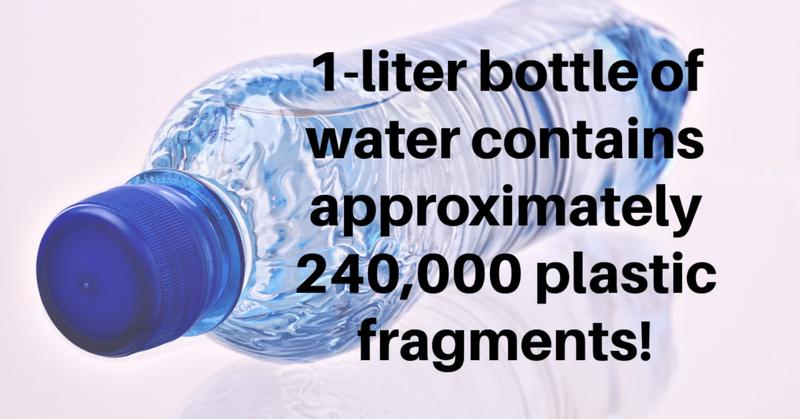Nanoplastics in Bottled Water Raise Concerns Over Health Impact
Nanoplastics in Bottled Water Raise Concerns Over Health Impact
In a groundbreaking study published in the Proceedings of the National Academy of Sciences, researchers have discovered that a typical 1-liter bottle of water contains approximately 240,000 previously undetected plastic fragments, raising significant concerns about the health implications of nanoplastic pollution. The findings indicate that health risks associated with plastic pollution may have been drastically underestimated, shedding light on a previously uncharted territory.
Nanoplastics: A Hidden Threat
The study is the first to assess bottled water specifically for the presence of "nanoplastics," which are plastic particles smaller than 1 micrometer in length—about one-seventieth the width of a human hair. Previous studies only accounted for larger microplastics, ranging from 1 to 5,000 micrometers. The new research suggests that bottled water may contain up to 100 times more plastic particles than previously estimated.
Nanoplastics pose a greater threat to human health as their minuscule size enables them to penetrate human cells, enter the bloodstream, and potentially impact various organs. Additionally, these particles can cross the placenta, exposing unborn babies to potential health risks. Despite suspicions about their presence in bottled water, the lack of technology to identify individual nanoparticles hindered previous research efforts.
Innovation in Detection Technology
To overcome this challenge, the study's co-authors developed a new microscopy technique, programmed a data-driven algorithm, and used both to analyze approximately 25 liters of bottled water purchased from three popular brands in the US. The researchers discovered 110,000 to 370,000 tiny plastic particles in each liter, with 90% classified as nanoplastics.
Naixin Qian, the lead author and a graduate student of chemistry at Columbia University, emphasized the significance of the study, stating, "This study provides a powerful tool to address the challenges in analyzing nanoplastics, which holds the promise to bridge the current knowledge gap on plastic pollution at the nano level."
Implications and Future Research
The study focused on seven common plastic types, including polyethylene terephthalate (PET), commonly used in water bottles, and polyamide, often found in water purification filters. However, numerous unidentified nanoparticles were also discovered in the water, suggesting that the prevalence of plastic in bottled water could be even higher.
Despite the alarming findings, the International Bottled Water Association called for a full scientific review of the study's methodology and stated that there is no scientific consensus on the potential health impacts of nano- and microplastic particles. The association did not comment on the specific findings of the study.
The co-authors of the research are not limiting their investigation to bottled water. They plan to extend their research to examine nanoplastics in tap water and snow samples collected from western Antarctica, emphasizing the need for a comprehensive understanding of the presence and impact of these particles.
The discovery of a significant number of previously undetected plastic fragments in bottled water raises crucial questions about the potential health risks associated with nanoplastic pollution. As scientists continue to delve into this unexplored realm, it becomes increasingly evident that nanoplastics pose a considerable threat to human health. The study serves as a call to action, urging further research and regulatory measures to address the pervasive issue of plastic pollution and its potential consequences for global health.
These nanoplastics include types such as polyamide (nylon), PET, polystyrene, PVC, and others. Some remain unidentified, suggesting even higher levels
This article highlights a pressing concern regarding our health and the hidden dangers of nanoplastics in bottled water. I recently started using glass water bottles to mitigate plastic exposure after learning about similar studies. It’s alarming how unaware we are of the plastic contamination in our everyday products. If you’re looking for a distraction from these worries, I suggest trying the ; it’s a fun way to ease your mind while staying aware of what's around us.
Nanoplastics pose a greater threat to human health because their extremely small size allows them to penetrate human cells , enter the bloodstream and potentially impact various organs.
One mistake and game over! I love the high-stakes feel of every run!
This nanoplastic research is concerning. Makes you think about hidden dangers, doesn't it? While scientists explore the unseen world of these particles in bottled water, tap water, and even Antarctic snow, I'm reminded of navigating the unseen dangers in . Avoiding those ghosts felt less stressful than contemplating nanoplastics! Hopefully, more research brings answers and solutions.
While there is no definitive conclusion about the dangers of nanoplastics, early signs suggest they could negatively affect human health.
This study is a stark reminder of the pervasive nature of plastic pollution and its potential to infiltrate every aspect of our lives, even something as seemingly pure as bottled water. The fact that nanoplastics, previously undetectable, are present in such high quantities is deeply concerning.
Nanoplastics are extremely small plastic particles, often less than 100 nanometers in size, which can be ingested through various sources, including bottled water.
Playing games can be a fantastic way to relieve stress. Whether through action games that help release pent-up energy or relaxing simulation games, gaming offers an escape from daily life where we can unwind and reset.
